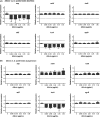Analyzing the antibacterial effects of food ingredients: model experiments with allicin and garlic extracts on biofilm formation and viability of Staphylococcus epidermidis
- PMID: 25838894
- PMCID: PMC4376410
- DOI: 10.1002/fsn3.199
Analyzing the antibacterial effects of food ingredients: model experiments with allicin and garlic extracts on biofilm formation and viability of Staphylococcus epidermidis
Abstract
To demonstrate different effects of garlic extracts and their main antibiotic substance allicin, as a template for investigations on the antibacterial activity of food ingredients. Staphylococcus epidermidis ATCC 12228 and the isogenic biofilm-forming strain ATCC 35984 were used to compare the activity of allicin against planktonic bacteria and bacterial biofilms. The minimal inhibitory concentration (MIC) and the minimum biofilm inhibitory concentration (MBIC) for pure allicin were identical and reached at a concentration of 12.5 μg/mL. MBICs for standardized garlic extracts were significantly lower, with 1.56 and 0.78 μg/mL allicin for garlic water and ethanol extract, respectively. Biofilm density was impaired significantly at a concentration of 0.78 μg/mL allicin. Viability staining followed by confocal laser scanning microscopy showed, however, a 100% bactericidal effect on biofilm-embedded bacteria at a concentration of 3.13 μg/mL allicin. qRT-PCR analysis provided no convincing evidence for specific effects of allicin on biofilm-associated genes. Extracts of fresh garlic are more potent inhibitors of Staphylococcus epidermidis biofilms than pure allicin, but allicin exerts a unique bactericidal effect on biofilm-embedded bacteria. The current experimental protocol has proven to be a valid approach to characterize the antimicrobial activity of traditional food ingredients.
Keywords: ATCC 12228; ATCC 35984; Allicin; Staphylococcus epidermidis; bacterial biofilm.
Figures






Similar articles
-
Garlic allicin as a potential agent for controlling oral pathogens.J Med Food. 2011 Nov;14(11):1338-43. doi: 10.1089/jmf.2010.0165. Epub 2011 May 6. J Med Food. 2011. PMID: 21548800
-
Lavage with allicin in combination with vancomycin inhibits biofilm formation by Staphylococcus epidermidis in a rabbit model of prosthetic joint infection.PLoS One. 2014 Jul 15;9(7):e102760. doi: 10.1371/journal.pone.0102760. eCollection 2014. PLoS One. 2014. PMID: 25025650 Free PMC article.
-
In vitro activity of allicin against Staphylococcus epidermidis and influence of subinhibitory concentrations on biofilm formation.J Appl Microbiol. 2003;95(4):709-11. doi: 10.1046/j.1365-2672.2003.02030.x. J Appl Microbiol. 2003. PMID: 12969283
-
Antimicrobial properties of hydrophobic compounds in garlic: Allicin, vinyldithiin, ajoene and diallyl polysulfides.Exp Ther Med. 2020 Feb;19(2):1550-1553. doi: 10.3892/etm.2019.8388. Epub 2019 Dec 27. Exp Ther Med. 2020. PMID: 32010337 Free PMC article. Review.
-
Therapeutic potential of garlic, aged garlic extract and garlic‑derived compounds on pancreatic cancer (Review).Biomed Rep. 2025 Jan 27;22(3):54. doi: 10.3892/br.2025.1932. eCollection 2025 Mar. Biomed Rep. 2025. PMID: 39926043 Free PMC article. Review.
Cited by
-
Polymicrobial Biofilm Dynamics of Multidrug-Resistant Candida albicans and Ampicillin-Resistant Escherichia coli and Antimicrobial Inhibition by Aqueous Garlic Extract.Antibiotics (Basel). 2022 Apr 25;11(5):573. doi: 10.3390/antibiotics11050573. Antibiotics (Basel). 2022. PMID: 35625217 Free PMC article.
-
Beyond Chemical Preservatives: Enhancing the Shelf-Life and Sensory Quality of Ready-to-Eat (RTE) Hummus with Vinegar and Other Natural Antimicrobials.Foods. 2023 Aug 4;12(15):2947. doi: 10.3390/foods12152947. Foods. 2023. PMID: 37569216 Free PMC article.
-
Antibacterial Properties of Organosulfur Compounds of Garlic (Allium sativum).Front Microbiol. 2021 Jul 27;12:613077. doi: 10.3389/fmicb.2021.613077. eCollection 2021. Front Microbiol. 2021. PMID: 34394014 Free PMC article. Review.
-
Anti-biofilm and Antibacterial Activity of Allium sativum Against Drug Resistant Shiga-Toxin Producing Escherichia coli (STEC) Isolates from Patient Samples and Food Sources.Indian J Microbiol. 2019 Jun;59(2):171-179. doi: 10.1007/s12088-019-00784-3. Epub 2019 Feb 18. Indian J Microbiol. 2019. PMID: 31031431 Free PMC article.
-
D-tryptophan, an eco-friendly natural, safe, and healthy compound with antimicrobial activity against food-borne pathogens: A systematic review.Food Sci Nutr. 2024 Feb 1;12(5):3068-3079. doi: 10.1002/fsn3.3987. eCollection 2024 May. Food Sci Nutr. 2024. PMID: 38726420 Free PMC article. Review.
References
-
- Aguirrezábal MM, Mateo J, Domínguez MC. Zumalacárregui JM. The effect of paprika, garlic and salt on rancidity in dry sausages. Meat Sci. 2000;54:77–81. - PubMed
-
- Amagase H. Clarifying the real bioactive constituents of garlic. J. Nutr. 2006;136:716S–725S. - PubMed
-
- Ankri S. Mirelman D. Antimicrobial properties of allicin from garlic. Microbes Infect. 1999;1:125–129. - PubMed
-
- Bachrach G, Jamil A, Naor R, Tal G, Ludmer Z, Steinberg D. Garlic allicin as a potential agent for controlling oral pathogens. J. Med. Food. 2011;14:1338–1343. - PubMed
LinkOut - more resources
Full Text Sources
Other Literature Sources
Molecular Biology Databases

